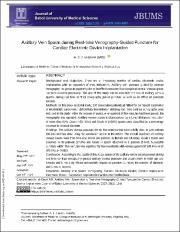| dc.contributor.author | al-Gburi, AJJ | en_US |
| dc.date.accessioned | 1401-12-09T23:06:42Z | fa_IR |
| dc.date.accessioned | 2023-02-28T23:06:43Z | |
| dc.date.available | 1401-12-09T23:06:42Z | fa_IR |
| dc.date.available | 2023-02-28T23:06:43Z | |
| dc.date.issued | 2023-03-01 | en_US |
| dc.date.issued | 1401-12-10 | fa_IR |
| dc.identifier.citation | (1401). مجله علمی دانشگاه علوم پزشکی بابل, 25(1), 10-19. | fa_IR |
| dc.identifier.issn | 1561-4107 | |
| dc.identifier.issn | 2251-7170 | |
| dc.identifier.uri | http://jbums.org/article-1-10804-en.html | |
| dc.identifier.uri | https://iranjournals.nlai.ir/handle/123456789/941211 | |
| dc.description.abstract | Background and Objective: There are an increasing number of cardiac electronic device implantation with an expansion of their indications. Axillary vein puncture guided by contrast venography has grown in popularity due to its effectiveness and low complication rate. Venous spasm has been reported previously. The aim of this study was to determine the rate of axillary venous spasms during real-time contrast venography-guided puncture as well as its effect on puncture success.
Methods: In this cross-sectional study, 137 consecutive patients admitted for permanent pacemaker or implantable cardioverter-defibrillator implantation utilizing real‑time contrast venography were included in the study. After the success of puncture or a period of five minutes had been passed, the venography was repeated. Axillary venous spasm is characterized by a lumenal diameter reduction of more than 50%. Grade I (50-90%) and Grade II (>90%) spasm were classified as a percentage decrease in lumenal diameter.
Findings: The axillary venous puncture within five minutes was successfully done in 124 patients (90.5%) and was done using the subclavian access in the others. The overall incidence of axillary venous spasm more than 50% was 33.6% (46 patients; 32 female and 14 male). Grade I spasm was observed in 38 patients (27.8%) and Grade II spasm observed in 8 patients (5.8%). Successful puncture within five minutes was significantly less in patients with venous spasm (37 (80.4%) vs 87 (95.6%), p=0.010).
Conclusion: According to the results of this study, spasm of the axillary vein is not uncommon during real-time contrast venography-guided axillary venous puncture and occurs more in older age and females and it has a significant unfavorable impact on puncture duration, the number of attempts, and puncture success. | en_US |
| dc.format.extent | 392 | |
| dc.format.mimetype | application/pdf | |
| dc.language | English | |
| dc.language.iso | en_US | |
| dc.publisher | دانشگاه علوم پزشکی بابل | fa_IR |
| dc.relation.ispartof | مجله علمی دانشگاه علوم پزشکی بابل | fa_IR |
| dc.relation.ispartof | Journal of Babol University Of Medical Sciences | en_US |
| dc.subject | Axillary Vein Spasm | en_US |
| dc.subject | Venography | en_US |
| dc.subject | Cardiac Electronic Device | en_US |
| dc.subject | Cardiac Implantable Electronic Device | en_US |
| dc.subject | Pacemaker | en_US |
| dc.subject | Implantable Cardioverter-Defibrillator. | en_US |
| dc.subject | Internal | en_US |
| dc.title | Axillary Vein Spasm during Real-time Venography-Guided Puncture for Cardiac Electronic Device Implantation | en_US |
| dc.type | Text | en_US |
| dc.type | Research | en_US |
| dc.contributor.department | 1.Department of Medicine, College of Medicine, al-Mustansiriyah University, Baghdad, Iraq. | en_US |
| dc.citation.volume | 25 | |
| dc.citation.issue | 1 | |
| dc.citation.spage | 10 | |
| dc.citation.epage | 19 | |





